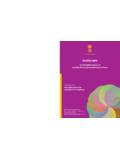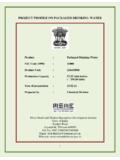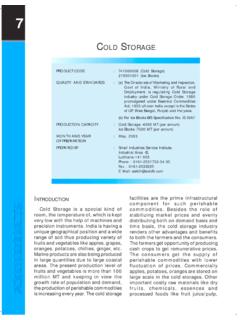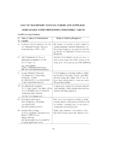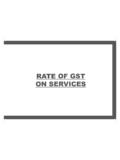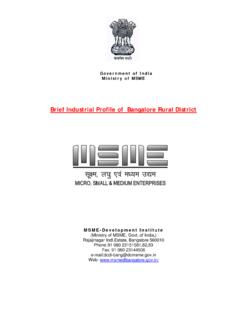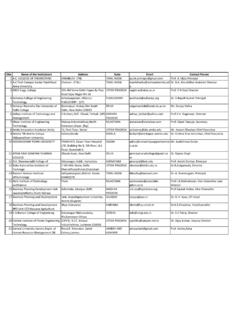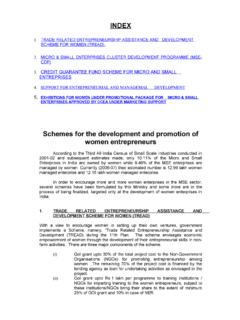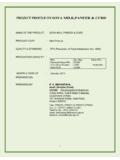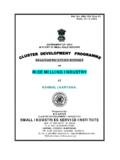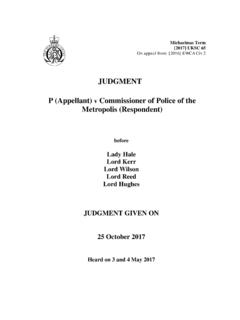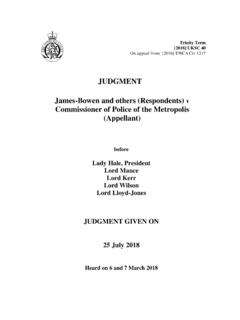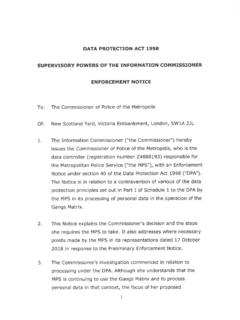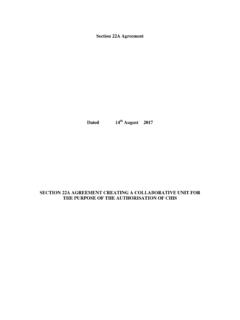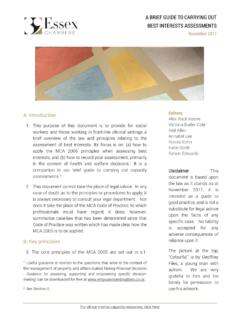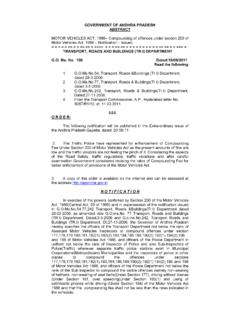Transcription of Brief Industrial Profile of Mumbai District - DCMSME
1 1 Government of India Ministry of MSME Brief Industrial Profile of Mumbai District MSME Development Institute Ministry of MSME, Government of India, Kurla-Andheri Road, Saki Naka, Mumbai 400 072. Tel.: 022 28576090 / 3091/4305 Fax: 022 28578092 e-mail: website: 2 Content Sl. No. Topic Page No. 1 General Characteristics of the District 3 Location & Geographical Area 3 Topography 4 Availability of Minerals. 5 Forest 5 Administrative set up 5 6 2 District at a glance: 6 7 Existing Status of Industrial Areas in the District Mumbai 8 3 Industrial scenario of Mumbai 9 Industry at a Glance 9 Year wise trend of units registered 9 Details of existing Micro & Small Enterprises and artisan units in the District . 10 Large Scale Industries/Public Sector undertaking.
2 10 Major Exportable item 10 Growth trend 10 Vendorisation /Ancillarisation of the Industry 11 Medium Scale Enterprises 11 List of the units in Mumbai District 11 Service Enterprises 11 Potentials areas for service industry 11 Potential for new MSME 12 13 4 Existing Clusters of Micro & Small Enterprises 13 Details of Major Clusters 13 Manufacturing Sector 13 Details for Identified cluster 14 Name of the cluster : Leather Goods Cluster 14 5 General issues raised by industry association during the course of meeting 14 6 Steps to set up MSMEs 15 Annexure - I 16 45 Annexure - II 45 - 48 3 Brief Industrial Profile of Mumbai District 1. General Characteristics of the District . Mumbai is the capital city of Maharashtra.
3 It is the most populous city in India, and the fourth most populous city in the world, with a total metropolitan area population of approximately million. Along with the neighboring urban areas, including the cities of Navi Mumbai and Thane, it is one of the most populous urban regions in the world. Mumbai lies on the west coast of India and has a deep natural harbor. Mumbai is the commercial and entertainment capital of India, it is also one of the world's top 10 centres of commerce in terms of global financial flow, generating 5% of India's GDP, and accounting for 25% of Industrial output, 70% of maritime trade in India ( Mumbai Port Trust &JNPT), and 70% of capital transactions to India's economy.
4 The city houses important financial institutions such as the Reserve Bank of India, the Bombay Stock Exchange, the National Stock Exchange of India, the SEBI and the corporate headquarters of numerous Indian companies and multinational corporations. It is also home to some of India's premier scientific and nuclear institute like BARC, NPCL, IREL, TIFR, AERB, AECI, and the Department of Atomic Energy. The city also houses India's Hindi (Bollywood) and Marathi film and television industry. Location and geographical Area. Mumbai consists of two distinct regions: Mumbai City District and Mumbai Suburban District , which form two separate revenue districts of Maharashtra.
5 The city District region is also commonly referred to as the Island City or South Mumbai . The total area of Mumbai is km2. Of this, the island city spans km2, while the suburban District spans 370 km2, together accounting for km2 under the administration of Brihan Mumbai Municipal Corporation (BMC). The remaining area belongs to Defence, Mumbai Port Trust, Atomic Energy Commission and Borivali National Park, which are out of the jurisdiction of the BMC. Mumbai lies at the mouth of the Ulhas River on the western coast of India, in the coastal region known as the Konkan. It sits on Salsette Island, partially shared with the Thane District . Mumbai is bounded by the Arabian Sea to the west. Many parts of the city lie just above sea level, with elevations ranging from 10 m to 15 m; the city has an average elevation of 14 m.
6 Northern Mumbai is hilly, and the highest point in the city is 450 m at Salsette in the Powai-Kanheri ranges. Sanjay Gandhi National Park (Borivali National Park) is located partly in the Mumbai suburban District , and partly in the Thane District , and it extends over an area of km2 . 4 TOPOGRAPHY The original seven islands of Bombay consisted of 22 hills. Most of them were razed to fill in the shallows to connect the islands. The hills still standing today are: Malabar Hill the highest point in the city area Cumbala Hill Antop Hill Sewri Hill Gilbert Hill Worli Hill Pali Hill Mazgaon Hill Sion Hill Mahakali Hill Golanji Hill Pulshachi Dongri Salamati Hill There are three hill ranges with the city limits.
7 The Ghatkopar Hills are present near the station of Ghatkopar. The hill range runs parallel to the Central Railway track and is inhabited by slums. During the monsoon season, landslides are common. The Trombay Hills occupy a large portion of Trombayon the eastern part of the city. The highest hill is about 302 metres above sea level. The Powai Hills are present north of the city. The Borivali National Park occupies most of the region. The Vihar and Tulsi Lakes are present within the hills. The highest point of the metropolis, at 450 metres, is located in this region. There are three lakes in the city. The Vihar Lake and the Tulsi Lake are present within the National Park and supply part of the city's drinking water.
8 The Powai Lake is immediately south of these two. Back Bay is the largest bay in the city. The coastline of Back Bay is an inverted C-shaped region 4 kilometres in length, and Marine Drive is located along this stretch. North of Marine Drive is Worli Bay. In the centre of the bay is the tomb of Haji Ali, a 13th century Muslim saint. The bay perimeter is about two kilometres in length. Mahim Bay is the second largest bay in the city. The Mithi River empties into the Mahim Creek which drains into the bay. The border between the city and its suburbs bisects the bay. To the north lies Bandra and to the south, Mahim. Mumbai has numerous creeks with close to 71 km2 of creeks and mangroves along its coastline. The Vasai Creek to the north and Thane Creek to the east separates Salsette Island from the mainland.
9 Within the city the Malad (or Marve) Creek and the Gorai (or Manori) Creek inundate the suburban region. The Mahim Creek forms the border between the two districts. On the eastern front, a large creek the Thane Creek is present. There are also the Mahul Creek and the Mahim Creek. 5 Availability of Minerals. There is no major mineral or mining in the District . FOREST District Geographical Area Dense Forest Open Forest Total Mangrove Scrub Dense Open Mumbai City 157 0 1 1 0 1 0 Mumbai Sub Urban 446 53 29 82 15 11 3 (Area in Sq. km) ADMINISTRATIVE SET UP Mumbai , extending from Colaba in the south, to Mulund and Dahisar in the north, and Mankhurd in the east, is administered by the Brihan Mumbai Municipal Corporation (BMC).
10 The BMC is in charge of the civic and infrastructure needs of the metropolis. The Municipal Commissioner is the chief Executive Officer and head of the executive arm of the Municipal Corporation. All executive powers are vested in the Municipal Commissioner who is an Indian Administrative Service (IAS) officer appointed by the state government. The Commissioner is appointed for a fixed term as defined by state statute. The powers of the Commissioner are those provided by statute and those delegated by the Corporation or the Standing Committee. The two revenue districts of Mumbai come under the jurisdiction of a District Collector. The Collectors are in charge of property records and revenue collection for the Central Government, and oversee the national elections held in the city.
